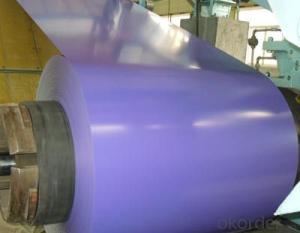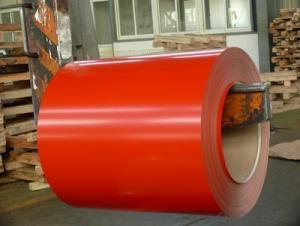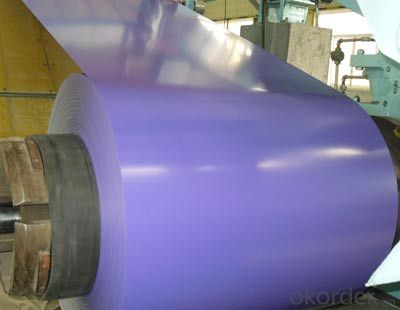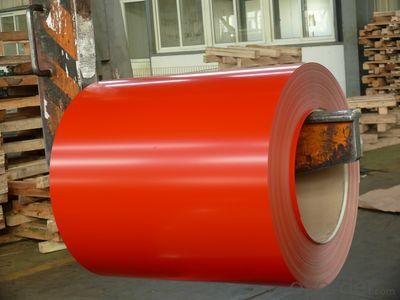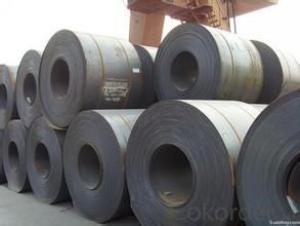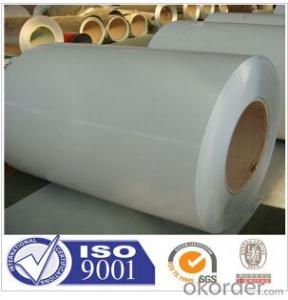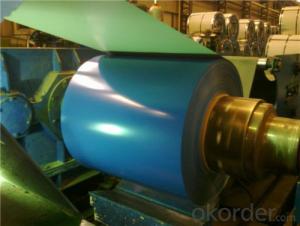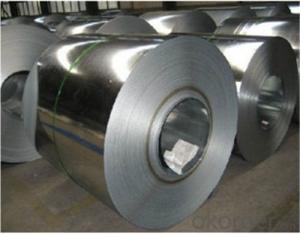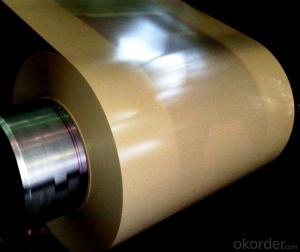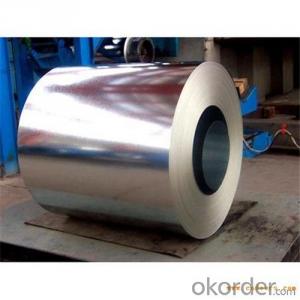prepainted Rolled steel Coil for Construction Roofing Constrution
- Loading Port:
- Shanghai
- Payment Terms:
- TT OR LC
- Min Order Qty:
- 50 m.t.
- Supply Capability:
- 30000 m.t./month
OKorder Service Pledge
OKorder Financial Service
You Might Also Like
Structure of Prepainted Rolled steel Coil for Construction Roofing
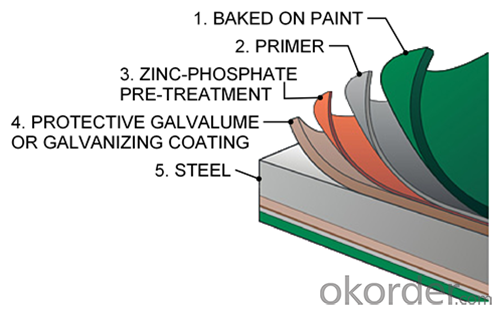
Description of Prepainted Rolled steel Coil for Construction Roofing
Prepainted Rolled steel Coil is a kind of coated steel coil/sheet. With the cold rolled steel of different strength and thickness as substrate, it is produced through applying Al-Zn coat on both faces by hot dip process. In its coating, Al accounts for about 55%, Si 1.6%, while the remaining is Zn. Aluminum zinc coils enjoys both the physical protective feature and durability of Al and the electrochemical protective property of Zn. And its surface has bright silver color and regular embossed-like figure, which are highly decorative.
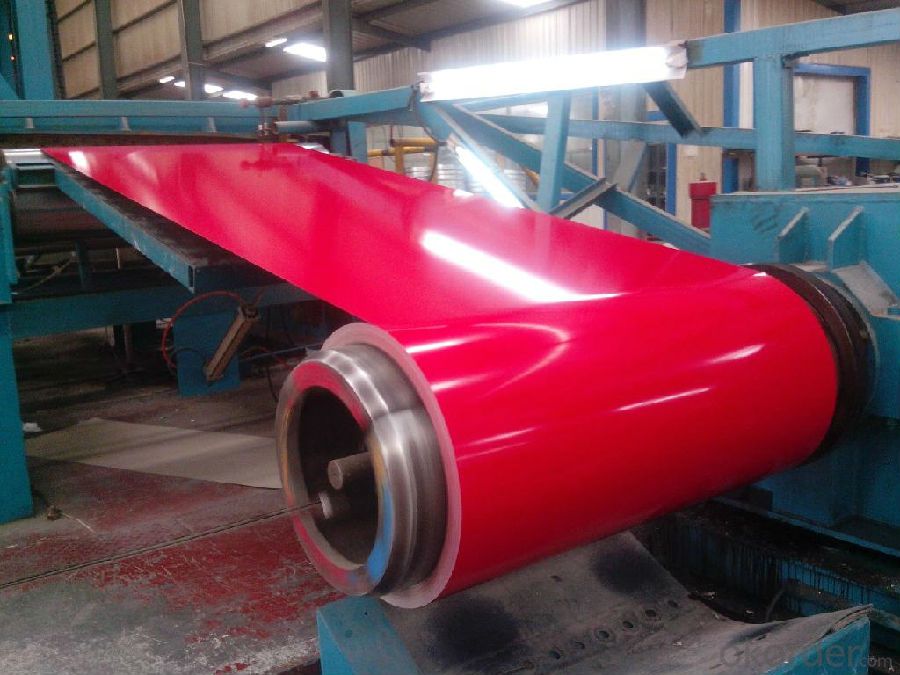

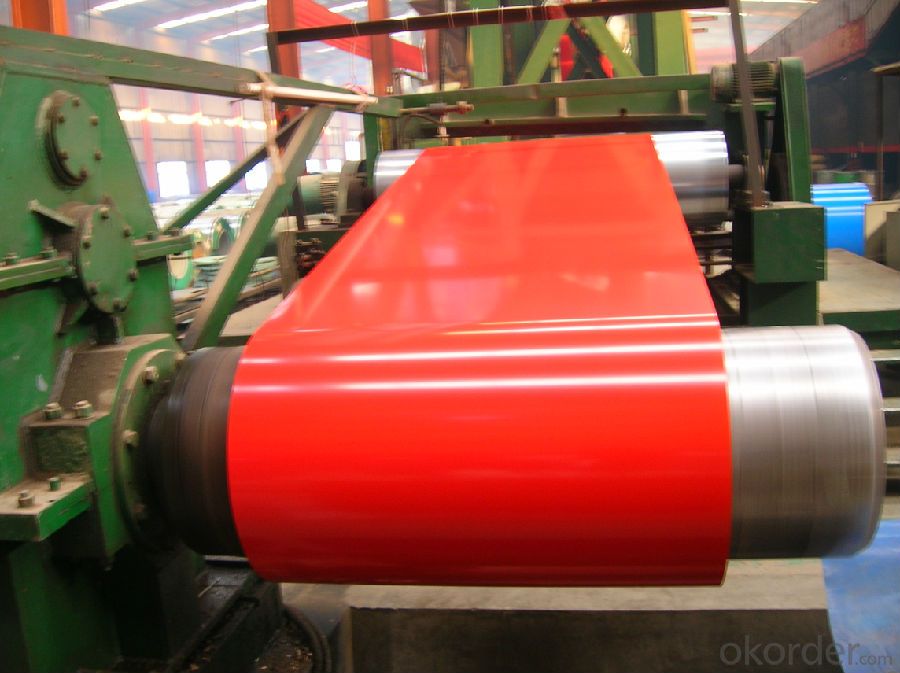
Main Feature of Prepainted Rolled steel Coil for Construction Roofing
1.Corrosion resistance: It mainly depends on the aluminum protection. When the zinc being worn, the aluminum will form a dense layer of aluminum oxide, resist corrosion material to prevent further corrosion inside.
2. Heat resistance: Aluminum zinc alloy steel sheet has excellent heat resistance, can withstand high temperatures over 300 centigrade, and is similar with aluminized steel high temperature oxidation resistance. It often used in chimney pipes, ovens, fluorescent lighting device and the device cover.
3. Heat reflective: Galvanized steel plate heat-reflective high rate is twice as galvanized steel, often used to make insulation materials.
4. Economy: Because density of 55% AL-Zn is smaller than the density of Zn, so in the same weight and thickness of Galvanized zinc layer, aluminum-zinc steel plate is larger area more than 3% of galvanized steel sheet.
Applications of Prepainted Rolled steel Coil for Construction Roofing
1. Construction and building: roofing; ventilating duct; handrail; partition panel;etc.
2. Electric appliance: refrigerator; washing machine; refrigerator; DVD;etc.
3.Transportation: oil tank; road sign; etc.
4.Agriculture:barn; etc.
5.Others:vending machine; game machine; etc.
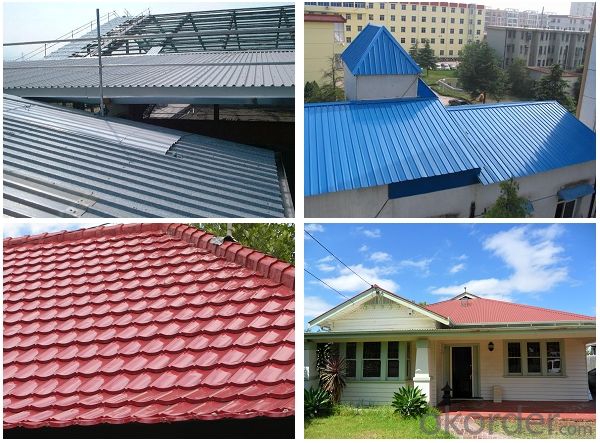
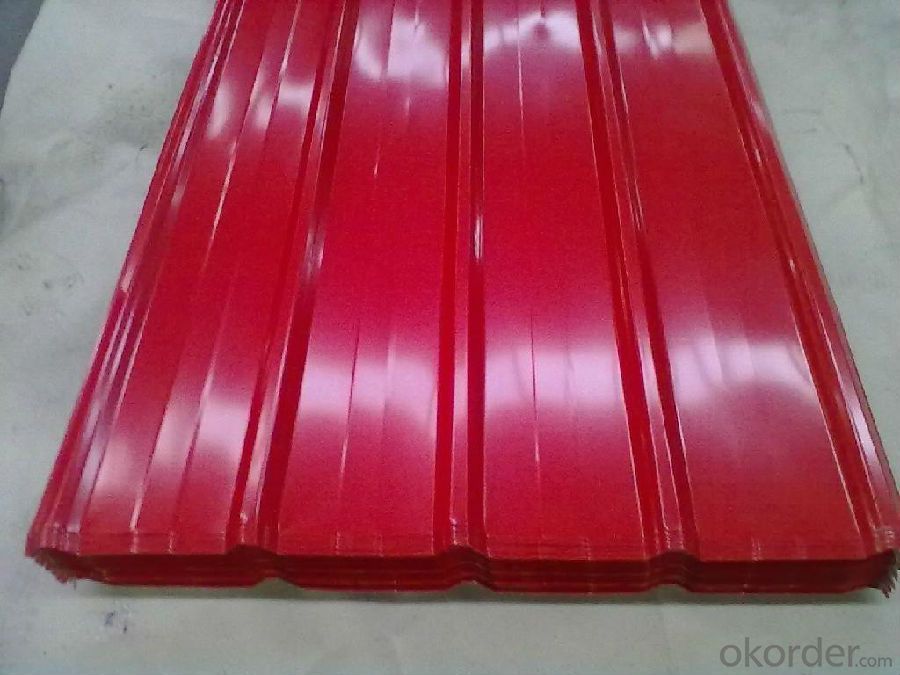
Specifications of Rolled steel Coil for Construction Roofing
Product | Prepainted Rolled steel Coil for Construction Roofing |
Material Grade | SGCC / SGCH / DX51D+AZ, etc |
Thickness | 0.2-3.0mm |
Width | 600-1500mm |
Tolerance | Thickness: +/-0.02mm , Width:+/-2mm |
Zinc-coating | AZ40-150g/m2 |
Technique | Raw material: Hot rolled steel coil --> Cold rolled_>hot dipped galvalume |
Surface | Dried, Chromated, Unoiled |
Spangle | Regular spangle , small spangle, zero spangle |
ID | 508MM |
Coil weight | 10MT max |
Export package | Cardboard inner sleeves, Waterproof paper, galvanized steel covered and steel strip packed |
FAQ of Prepainted Rolled steel Coil for Construction Roofing
We have organized several common questions for our clients,may help you sincerely:
1. What is the minimum order quantity ?
Our MOQ is 50mt for each size. And we will consider to give more discount if you make big order like 1000 tons and more. Further more, the more appropriate payment term your offer the better price we can provide.
2. How long can we receive the product after purchase?
Usually within thirty working days after receiving buyer’s advance payment or LC. We will arrange the factory manufacturing as soon as possible. The cargo readiness usually takes 15-25 days, but the shipment will depend on the vessel situation.
3. How to guarantee the quality of the products?
We have established the international advanced quality management system,every link from raw material to final product we have strict quality test;We resolutely put an end to unqualified products flowing into the market. At the same time, we will provide necessary follow-up service assurance.
- Q: What are the different coil leveling methods used for steel coils?
- Steel coils can be leveled using various methods, each with its own advantages and limitations. Here are some commonly used methods: 1. Roller Leveling: Coils pass through rollers that apply pressure to flatten and level them. This method is effective in reducing coil crown or center buckle and eliminating coil memory. However, it may not be suitable for coils with severe shape defects or variations. 2. Stretch Leveling: Coils are stretched to remove shape defects. Gripper heads hold the edges of the coil while it is stretched. Stretch leveling is particularly effective in correcting crossbow and edge wave defects. However, it may cause elongation and yield loss in the material. 3. Temper Pass: Coils go through temper mill stands, where tension and compression forces are applied. Temper pass leveling improves flatness and removes coil memory. It is commonly used for thinner gauge steel coils but may not be suitable for thicker coils. 4. Corrective Leveling: This method is used for coils with severe shape defects. Skilled operators selectively remove material from specific areas of the coil to correct the shape. Corrective leveling effectively eliminates shape defects and improves flatness but requires significant labor. 5. Tension Leveling: Coils undergo tension forces while passing through pinch rolls. Tension leveling removes coil memory and improves flatness, especially for coils with edge wave defects. However, it may cause elongation and yield loss in the material. These are just a few of the coil leveling methods used for steel coils. The choice of method depends on specific requirements and desired flatness results. Considerations such as material thickness, shape defects, and production capacity are important in selecting the appropriate leveling method.
- Q: I should have known, but magnets don't stick to stainless steel, so now I'm at a loss, I can't display my photos on the fridge. any ideas?
- An Italian theme would be great for that or just sleek clean lines with the colors stainless steal, red, and accented with black. I like that personally. But it is up to you and what you like and don't like. You could also go an Asian theme. That would be pretty. Asian stuff seems to lean toward reds, greens, and neutrals.
- Q: 420 440 1045 or 1065 ive bought knifes with these steel grades and i want to know which one is better.
- SAE 440 is the best. Classified as high grade cutlery steel. There are various grades of 440: A, B, C, and F. 440 A is the most stain resistant while 440 C has the most carbon and can achieve the highest hardness (Best edge Retention). SAE 440 Chemistry: 16 - 18% Chromium, 0.60 - 1.2% Carbon, 0.75% Molybdenum. SAE 420 is pretty good. Classified as cutlery steel, it is a stain resistant grade but has less chromium and significantly less carbon than SAE 440. SAE 420 Chemistry: 12 - 14% Chromium, 0.15% Carbon (min), 0 Molybdenum Chromium is what makes the steel corrosion resistant. It also adds toughness. Molybdenum adds extra corrosion resistance and adds hardenability. So you can see by chemical components that 440 is highest quality although that also means more cost. 1045 and 1065 are low quality steels and you should probably never use them for a knife. The 1 indicates plain carbon steel with little other alloying elements. The last two digits indicate how much carbon is in the steel. 1045 has 0.45% carbon, mid-range hardenability. 1065 has 0.65% carbon, high hardenability. So if I had to choose I would choose 1065 over 1045 but the difference isn't that noticeable. Everything I said here assumes they have all had the optimum Quench and Temper heat-treatment for their chemistry grade.
- Q: How are steel coils used in the aerospace industry?
- Steel coils are used in the aerospace industry for various applications such as structural components, engine parts, and aircraft frame construction. These coils are often used in the manufacturing process to fabricate strong and durable components that can withstand the extreme conditions of flight.
- Q: What are the common coil finishes available for steel coils?
- There are several common coil finishes available for steel coils, each serving different purposes and providing distinct aesthetic appearances. Some of the most frequently used coil finishes include: 1. Hot-dip galvanized: This finish involves immersing the steel coil in a bath of molten zinc, which forms a protective layer on its surface. It provides excellent corrosion resistance and is widely used in outdoor applications such as roofing, fencing, and automotive parts. 2. Galvannealed: This finish is achieved by annealing the hot-dip galvanized steel coil, resulting in a matte gray appearance. Galvannealed coils offer enhanced paint adhesion, making them suitable for applications that require subsequent painting or powder coating, such as appliances and furniture. 3. Electro-galvanized: In this process, a thin layer of zinc is electroplated onto the steel coil's surface. Electro-galvanized finishes provide good corrosion resistance and are commonly used in indoor applications, such as electrical enclosures, HVAC systems, and automotive components. 4. Pre-painted or coated: These finishes involve applying a layer of paint or a coating system to the steel coil, enhancing its appearance and providing additional protection. Pre-painted coils are extensively used in construction, appliances, and automotive industries due to their aesthetic appeal and corrosion resistance. 5. Bare or mill finish: This finish refers to the untreated, raw steel coil without any additional coatings or finishes. Bare steel coils are commonly used in applications where corrosion resistance is not a primary concern, such as structural components, pipes, and tubes. These are just a few of the most common coil finishes available for steel coils, and each offers unique properties and advantages depending on the intended use of the steel coil. It is important to carefully consider the specific requirements of the application to choose the most suitable coil finish.
- Q: I just got the game Red Steel for the Wii. I want to use the sword in multiplayer mode, but I can't find it. Is it only for single player?
- Dude i hate to break it to you but its only single player, and if your talking about the first Red Steel, you can only use the sword in special moments in the game or showdowns i think that's what its called, but i play Red Steel 2, and its a better game, and you can use the sword anytime you want to, but again no online play, but it would be kinda nice to have it, just a thought!!! LoL Hope that helps....
- Q: How are steel coils transported internationally?
- Typically, steel coils are shipped internationally by sea due to their heavy and bulky nature, which makes air transportation impractical. The most common method involves using specialized shipping containers called flatracks or open-top containers, which allow for easy loading and unloading onto vessels. Before being transported, the steel coils are typically securely strapped or banded together to prevent movement or damage during transit. Cranes or forklifts are then used to load the coils onto the flatracks or open-top containers. Careful placement and securing of the coils onto the containers ensure stability and prevent shifting during the journey. Once loaded, the containers are sealed and taken to the nearest port, where they are loaded onto cargo ships designed specifically for heavy and oversized cargo. These ships are equipped with specialized handling equipment like cranes and ramps to facilitate container handling. During the journey, the cargo ships adhere to predetermined shipping routes to reach the destination port. The duration of the journey depends on the distance between the origin and destination ports. Since steel coils are typically transported in large quantities, multiple containers may be loaded onto a single ship. Upon arrival at the destination port, cranes or ramps are used to unload the containers from the cargo ship. The steel coils are then carefully removed from the containers and transported to their final destination, which may involve further transportation by road or rail. Throughout the transportation process, it is crucial to adequately protect the steel coils from moisture, corrosion, and other potential damages. Special attention is given to handling and stowage to minimize the risk of structural damage or deformation. In conclusion, specialized shipping containers are utilized to transport steel coils internationally by sea. The coils are securely loaded onto flatracks or open-top containers and transported by cargo ships to the destination port. Proper handling and stowage techniques are employed to ensure the safe and secure transportation of the steel coils.
- Q: Are steel coils susceptible to damage during storage or transportation?
- Yes, steel coils are susceptible to damage during storage or transportation. Factors such as mishandling, improper stacking, exposure to moisture or extreme temperatures, and inadequate packaging can lead to dents, scratches, corrosion, and even deformation of the coils. Adequate precautions and secure packaging are necessary to minimize the risk of damage during storage or transportation.
- Q: I would like to build steel galvanization plant.
- How big of a kettle do you want to go with? A small 6-10 foot kettle would work fine for spinner work (small parts ran in baskets) but if you want to handle large beams and so forth you will need to have at least a 25 foot or longer kettle. You will need tanks for caustic,acid,rinsing,and preflux solutions. If you go with sulfuric acid it will have to be heated. The caustic and flux tanks need to be heated in any case.You will also need a bag house to control smoke coming off the kettle. First you should look into permits such to see if you can actually build this plant. Galvanizing is nasty work and the laws and regs are strict. Former Kettleman
- Q: How are steel tape measures installed?
- The spring piece is fixed on the shaft, the other end is connected with the measuring tape core, fixed tape shell with a shaft, the spring plate and a circle around the axis of the ruler core, wrapped after the ruler core extends from the outer end of the incision length of the shell, gently pull, the spring is tightened, the pull out the part from the incision and then removed around the shaft, then gently pull out, and then put the ruler core tied to the shaft, removed from the incision so repeatedly, until the spring to put all the ruler core recovery. Then a cotter pin on the central shaft installed on the lid, will tighten the screws.
Send your message to us
prepainted Rolled steel Coil for Construction Roofing Constrution
- Loading Port:
- Shanghai
- Payment Terms:
- TT OR LC
- Min Order Qty:
- 50 m.t.
- Supply Capability:
- 30000 m.t./month
OKorder Service Pledge
OKorder Financial Service
Similar products
Hot products
Hot Searches
Related keywords
